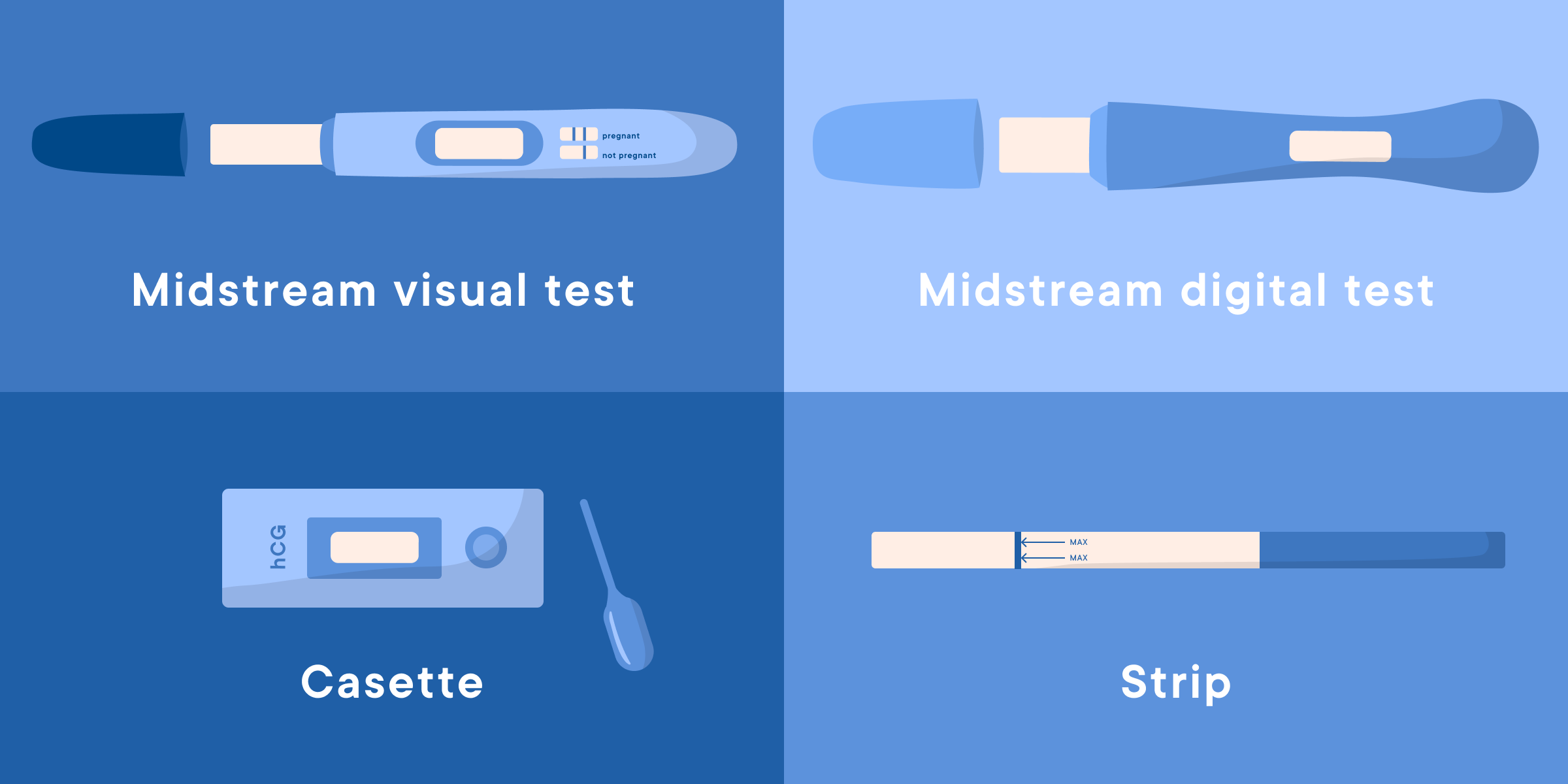Illustration by Emma Günther
How soon can I take a pregnancy test?
Testing too soon can increase the chances of a false negative—here’s what you need to know.

Top things to know:
Urine pregnancy tests are most reliable 1–2 weeks after a missed period
Test first thing in the morning for the best chance of an accurate result
Follow the instructions provided with the pregnancy test carefully
This article is for people trying to conceive, offering guidance on when and how to test if you're actively trying to get pregnant. It will help you choose which test to take, determine the best time to take it, and know what to do if you get a positive or negative result.
(Not trying to conceive? Check out our other article on pregnancy tests instead.)
When should I take a pregnancy test?
If you think you might be pregnant, a home urine pregnancy test is usually a good first step. It can be difficult to wait to test, especially if you’re eager for an answer. Remember, each brand has its own guidelines on when to test.
For the most accurate results, it’s recommended to take a urine pregnancy test 1–2 weeks after your missed period (1).
While you can test sooner, you may get a false negative result (2). This is when you test negative despite being pregnant (3).
Menstrual cycle length and ovulation can vary from cycle to cycle, so it’s easy to miscalculate when your period is due (4). This explains why 10–20% of pregnant people get a false-negative result on the first day of a missed period (1).
If you’ve been using ovulation prediction tests, you’ll have a better idea of when you ovulated. In that case, aim to take a pregnancy test at least two weeks after ovulation (1).
What if I have an irregular cycle?
If your cycle varies in length, figuring out the best time to test can be trickier (1). Tracking your range of cycle lengths can help. For example, if your cycles range from 28–36 days, you can wait until day 37 has passed to confirm you’ve truly missed your period. Once you’re 1–2 weeks late, a urine pregnancy test is much more likely to be accurate (1).
When is the best time of day to take a pregnancy test?
You can take a urine pregnancy test any time of day, but first thing in the morning is ideal (1). Your urine is most concentrated with the pregnancy hormone human chorionic gonadotropin (hCG) at that time. This helps lower the chance of a false-negative result (1).
What kind of pregnancy tests are available?
There are two main types of pregnancy tests (5):
Urine tests
Blood tests
Both tests detect hCG, a hormone that rises once an embryo implants in the uterus. The level of hCG roughly doubles every 37–48 hours and reaches its highest point at around 8–12 weeks of pregnancy (5).
Urine pregnancy tests
When used correctly, urine pregnancy tests are reliable (3). They detect hCG in urine when it reaches a certain level, usually between 20–50 IU/L (more on this below) (6). You can take a urine pregnancy test at home, and the results appear within 5–10 minutes (6).
This kind of test is qualitative, which means results are reported as “positive” or “negative” (6). It does not tell you how much hCG is in the urine (6).
If you take a urine pregnancy test too soon, the level of hCG in your body may still be too low to detect (3). This means you can get a negative result even if you’re pregnant (3).
Your healthcare provider might also carry out a urine test in the office. Because there’s less chance of user error, these results can be more reliable (1).
Blood pregnancy tests
Your healthcare provider can also perform a blood test (1). Unlike urine tests, this kind of test is quantitative, which means it measures the precise amount of hCG in the blood (6).
A small sample of blood is drawn with a needle and sent to a laboratory (1). The results can take anywhere from a few hours to more than a day.
Blood pregnancy tests are more expensive and take longer than urine pregnancy tests, so they’re typically only done if there’s a medical reason to do so.
Choosing the right pregnancy test
The most important factor when taking a pregnancy test is to follow the instructions provided with the test you’ve purchased. Here are some things to keep in mind when choosing a pregnancy test:
Test Sensitivity
Some home pregnancy tests are more sensitive than others, which means they can detect lower amounts of hCG (7). This information is included in the test box.
Sensitivity is typically labeled in IU/L or mIU/ml. Most home tests can detect hCG levels between 20–25 IU/L, though some can detect as low as 6.3 IU/L (8). A lower number means a higher sensitivity (7).
Be cautious of brands that claim “early results” several days before your period is due. Studies show these claims can be misleading and may lead to more false negatives (2).
Does format matter?
Pregnancy tests come in different formats, and some instructions are easier to understand than others (9,10). Choose the test that feels most convenient for you.
For midstream tests, you must hold the absorbent side of the test under your urine stream (3). For others, you may have to collect your urine in a container and dip a testing strip in the sample, or a dropper may be provided to place a small urine sample onto a testing area (3).
Choosing one format over the other is a matter of personal preference, but it’s important to follow the specific instructions closely (10).

Cost
You may conceive on your first try, but for some, it may take up to 12 months or longer (11). Since the number of tests you’ll need is uncertain, cost can be an important factor when deciding which test to purchase. If you plan to test often, cheaper strip tests might be a good option. In some countries, strip tests may only be available to purchase online (10). In the USA, dollar stores or discount retailers often carry affordable options.
Clarity of results
Pregnancy tests display results in several different ways. A positive result could be indicated with two lines, a plus sign, or the words “yes” or “pregnant”. Always check the instructions to confirm how a positive result will be shown.
On midstream visual pregnancy tests, the first line of the test is the control line, which shows that the test worked (3). The appearance of a second line (faint or bold) means you’re pregnant (3). Faint lines can be easy to misread (3,12). Newer digital tests display words like “pregnant” or “not pregnant”, making them easier to read (12,13).
Can a pregnancy test be negative but I’m still pregnant?
Yes. If your test is negative but your period hasn’t arrived, you may have:
Tested too early, when hCG was still low (2)
Diluted your urine by drinking lots of fluids (14)
Try testing again in a few days, preferably first thing in the morning (1). If you think you’re pregnant but your first test was negative, hCG levels may rise enough to give a positive result later on (1).
Consider any negative result as tentative. If there's a possibility you could be pregnant, avoid alcohol or smoking until you’re certain.
If you’re still unsure, talk to your healthcare provider. They can do a blood test to get a more precise count of your hCG levels (1). Your medical history, a physical examination, and other tests can offer more clarity (1). Even if your test is negative, trust your instincts and speak to a healthcare provider if something feels off.
What to do if your pregnancy test is positive
If you have been trying to conceive and get a positive result; congratulations! Here’s what to do next:
Contact your healthcare provider to book a prenatal appointment
You might have to wait several weeks for this appointment, but you may be seen sooner if you have a history of miscarriage or chronic conditions like diabetes or hypothyroidism. Be sure to mention your medical history when making the appointment. During this visit, your healthcare provider may confirm your pregnancy with another test and estimate your due date (15).
2. Take a prenatal vitamin with folic acid
It’s recommended to start taking folic acid before becoming pregnant to reduce the risk of neural tube defects (birth defects affecting the brain and spine) (15).
3. Take care of yourself
Pregnancy creates extra demands on your body (16). Pay attention to early pregnancy symptoms like appetite changes, fatigue, or nausea. Maintaining a diet rich in fruits and vegetables helps provide the key vitamins and minerals needed to support the growth of the fetus as the pregnancy progresses (16).
High levels of stress can lead to physical changes in the body that can negatively impact your health and pregnancy (17). Find ways to manage stress in ways that work for you—whether that’s through self-care activities, quiet time, or talking to a professional.
Is it possible to get a false positive pregnancy test result?
Yes, but it’s rare (18). If you get a positive result, follow up with your healthcare provider.
If you’ve had a positive result followed by a negative result a few days later, it could be a chemical pregnancy, which is a very early loss soon after implantation (19).
If you’re using fertility treatments involving hCG injections, testing too early can give a false positive (20).
Whatever the result, you’re not alone
Trying to conceive can be an emotional journey. When you’re ready to test, remember these key points:
Wait at least 1–2 weeks after a missed period before testing, and use your first urine of the day.
Testing too early can lead to a false negative.
If you’re unsure about your result, test again in a few days or talk to a healthcare provider.
It’s understandable if you want to test as soon as possible. Keeping these points in mind may spare you some unnecessary heartache. Whether your test is positive, negative, or unclear, always reach out to your healthcare provider if you think you might be pregnant.
FAQs
How long after ovulation should I wait to test?
If you’ve been tracking ovulation accurately, most pregnancy tests can detect hCG around 12–15 days post-ovulation (1).
Can stress affect pregnancy test results?
Stress doesn’t typically alter hCG levels, so it won’t directly affect test accuracy. However, stress can affect your cycle, which may make it harder to time your test correctly.
Can I be two weeks pregnant and test negative?
Yes. If the hCG level isn’t high enough yet (or if your dates are off), you could be pregnant and still test negative. Testing again a few days later (preferably in the morning) can give a more accurate result (1).
